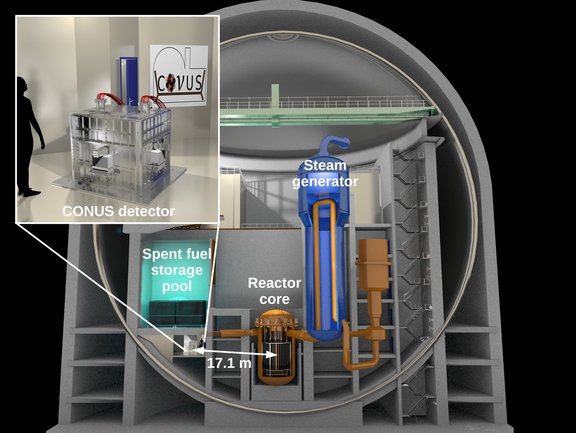The CONUS experiment of the MPI for Nuclear Physics began taking data in April 2018 in close collaboration with the PreussenElektra GmbH nuclear power plant in Brokdorf. It uses antineutrinos for the measurements, which are produced as a by-product in the reactor. The distance between the experimental setup, which is located in the inner safety containment of the plant, and the reactor core is only 17 metres (see figure). This provides an extremely high flux of 24 trillion neutrinos per second per square centimetre. The combination of a powerful source, special shielding against interfering radiation from the environment and optimised semiconductor detectors made of germanium makes the experiment a world-leading project in this field. “The design of the shielding is based on MPIK's many years of experience with high-purity materials whose radioactivity is several orders of magnitude below the natural ambient radiation. Thus, we were able to achieve near-surface conditions in the inner space of the reactor for which one usually has to go deep underground, such as in the Gran Sasso underground laboratory”, explains Manfred Lindner, Director of the division "Particle and Astroparticle Physics" at MPIK.
The current publication uses data from phases in which the reactor was switched on and off. This makes it possible to investigate the sought-after processes more precisely and to narrow down the possibilities of novel physics further than ever before. A material property of germanium, so-called "quenching", has so far limited the accuracy of measurements. The ionisation energy measured in the semiconductor detector is lower for neutrinos colliding with atomic nuclei than for electrons of the same energy. This loss effect must be considered accordingly in the analysis and evaluation of the data. “Therefore, to better understand the data at the reactor, we carried out parallel measurements at the Physikalisch-Technische Bundesanstalt in Braunschweig to determine the quenching effect more precisely than before,” says Werner Maneschg. Christian Buck adds: “Combined with additional data sets, this will allow the CONUS collaboration to further refine the results in the future and take an even closer look at the interactions in question.”
The novel interactions of the neutrinos can be described − similar to the weak force in the Standard Model of particle physics − at low energies as a certain mode of interaction, known to theorists as “effective four-Fermi interactions”. These so-called NSI operators can be further classified according to their properties with respect to space-time. The new results from the CONUS experiment now provide the world's narrowest bounds for new physics in the case of some of these channels. The obtained exclusion ranges for NSI operators correspond to bounds for a combination of the masses and coupling strengths of theoretically well-motivated novel bosons. For other channels, previous results are confirmed.
The CONUS measurement setup, which has been further improved this year, is currently collecting data with the reactor switched on until the end of the year. The upcoming shutdown of the power plant in Brokdorf in 2022 will allow very careful background measurements thereafter, and further important results from the CONUS project can be expected.
Original publication:
Novel constraints on neutrino physics beyond the standard model from the CONUS experiment, CONUS Collaboration, arXiv: https://arxiv.org/abs/2110.02174
